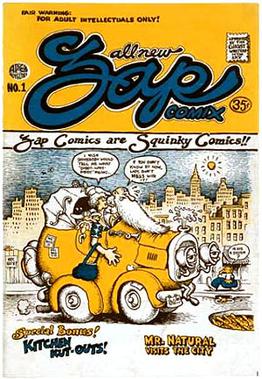Related Research Articles

Underground comix are small press or self-published comic books that are often socially relevant or satirical in nature. They differ from mainstream comics in depicting content forbidden to mainstream publications by the Comics Code Authority, including explicit drug use, sexuality, and violence. They were most popular in the United States in the late 1960s and 1970s, and in the United Kingdom in the 1970s.

Pee-wee's Playhouse is an American comedy children's television series starring Paul Reubens as the childlike Pee-wee Herman that ran from 1986 to 1990 on Saturday mornings on CBS, and airing in reruns until July 1991. The show was developed from Reubens's popular stage show and the TV special The Pee-wee Herman Show, produced for HBO, which was similar in style but featured much more adult humor.

Kim Deitch is an American cartoonist who was an important figure in the underground comix movement of the 1960s, remaining active in the decades that followed with a variety of books and comics, sometimes using the pseudonym Fowlton Means.

Franklin Christenson "Chris" Ware is an American cartoonist known for his Acme Novelty Library series and the graphic novels Jimmy Corrigan, the Smartest Kid on Earth (2000), Building Stories (2012) and Rusty Brown (2019). His works explore themes of social isolation, emotional torment and depression. He tends to use a vivid color palette and realistic, meticulous detail. His lettering and images are often elaborate and sometimes evoke the ragtime era or another early 20th-century American design style.

Charles Burns is an American cartoonist and illustrator. His early work was published in a Sub Pop fanzine, and he achieved prominence in the early issues of RAW. His graphic novel Black Hole won the Harvey Award.
Manuel Rodriguez, better known as Spain or Spain Rodriguez, was an American underground cartoonist who created the character Trashman. His experiences on the road with the motorcycle club, the Road Vultures M.C., provided inspiration for his work, as did his left-wing politics. Strongly influenced by 1950s EC Comics illustrator Wally Wood, Spain pushed Wood's sharp, crisp black shadows and hard-edged black outlines into a more simplified, stylized direction. His work also extended the eroticism of Wood's female characters.

Robert L. Williams, often styled Robt. Williams, is an American painter, cartoonist, and founder of Juxtapoz Art & Culture Magazine. Williams was one of the group of artists who produced Zap Comix, along with other underground cartoonists, such as Robert Crumb, S. Clay Wilson, and Gilbert Shelton. His mix of California car culture, cinematic apocalypticism, and film noir helped to create a new genre of psychedelic imagery.
Dennis Worden is an American comic book writer and artist best known as the creator of the comic book Stickboy.

William Henry Jackson Griffith is an American cartoonist who signs his work Bill Griffith and Griffy. He is best known for his surreal daily comic strip Zippy. The catchphrase "Are we having fun yet?" is credited to Griffith.

Zongo Comics was founded and published in 1995 by Simpsons and Futurama creator Matt Groening. Unlike its counterpart Bongo Comics, the comics published were geared towards older audiences containing adult material and did not include any adaptations of Groening's cartoons. The only two titles in the Zongo Comics range were Jimbo and Fleener.
Roberta Gregory is an American comic book writer and artist best known for the character Bitchy Bitch from her Fantagraphics Books series Naughty Bits. She is a prolific contributor to many feminist and underground anthologies, such as Wimmen's Comix and Gay Comix.

Carol Tyler is an American painter, educator, comedian, and eleven-time Eisner Award-nominated cartoonist known for her autobiographical comics. She has received multiple honors for her work including the Cartoonist Studio Prize, the Ohio Arts Council Excellence Award, and was declared a Master Cartoonist at the 2016 Cartoon Crossroads Columbus Festival at the Billy Ireland Cartoon Library & Museum.

Trina Robbins was an American cartoonist. She was an early participant in the underground comix movement, and one of the first women in the movement. She co-produced the 1970 underground comic It Ain't Me, Babe, which was the first comic book entirely created by women. She co-founded the Wimmen's Comix collective, wrote for Wonder Woman, and produced adaptations of Dope and The Silver Metal Lover. She was inducted into the Will Eisner Hall of Fame in 2013 and received Eisner Awards in 2017 and 2021.
Jimbo's Inferno is a 2006 graphic novel created by Gary Panter and published by Fantagraphics Books. The "inferno" is a Los Angeles mall named Focky Bocky.

Gary Hallgren is an American illustrator and underground cartoonist. Illustrations by Hallgren have been "commissioned by publications such as The New York Times, Men's Health, The Wall Street Journal, Mad, and Entertainment Weekly, among others."

Dennis P. Eichhorn was an American writer, best known for his adult-oriented autobiographical comic book series Real Stuff. His stories, often involving, sex, drugs, and alcohol, have been compared to those of Jack Kerouac, Ken Kesey, and Charles Bukowski.
J. R. Williams is an American cartoonist, animator, and fine artist best known for his late 1980s/early 1990s work in alternative comics. Known for his manic, exaggerated cartooning style, Williams brought an underground comix edge to his work during this period. Williams' characters Skinboy and the Bad Boys made recurring appearances in many of his stories.
R. Kalynn Campbell Jr, is an American artist, illustrator, cartoonist and writer/poet. He is best known for his work in the Lowbrow/Kustom Kulture movement, wherein he has been referred to as 'one of the most influential of the California Lowbrow artists'. As an illustrator, he created album/CD covers for notable bands like Megadeth, Reverend Horton Heat, and Social Distortion. His political cartoons were a fixture in Paul Krassner's 'The Realist' magazine from 1985 to 2001.
Raw Books & Graphics is an American publishing company specializing in comics and graphic novels. Operating since 1978, it is owned and operated by Françoise Mouly. The company first came to prominence publishing Raw magazine, co-edited by Mouly and her husband, cartoonist Art Spiegelman. In the 1980s the company published graphic novels, and with the formation of Raw Junior in 1999, branched into children's comics with Little Lit and Toon Books.

Ben Passmore is an American comics artist and political cartoonist.